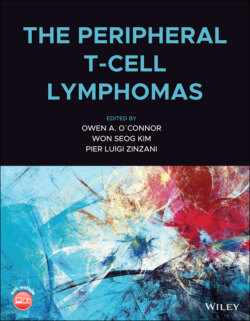Читать книгу The Peripheral T-Cell Lymphomas - Группа авторов - Страница 99
Adult T‐cell Lymphoma/Leukemia(HTLV Associated)
ОглавлениеATLL is an often aggressive and relatively uncommon PTCL associated with infection by human T‐cell lymphotropic virus type 1 (HTLV1). Incidence of ATLL varies by geographical region and population according to the prevalence of HTLV‐1 infection [10]. Most affected patients live or originate from those areas where HTLV1 infection is endemic, such as several islands in the Caribbean basin (e.g. Jamaica and Trinidad), southern Japan, western Africa, northeast Iran, Peru, and the southeastern portion of the United States [45–49]. Epidemiologic studies suggest that HTLV‐1 is primarily transmitted by breastfeeding, although spread via blood transfusion, sharing of needles, and sexual intercourse also occurs.
About 2.5% of people infected with HTLV1 are estimated to be subsequently diagnosed with ATLL [50, 51]. Patients infected as adults are less likely to develop ATLL compared with those exposed as children [52]. Contrasting evidence in gender distribution was noted with one study reporting equal incidence in males and females [53], whereas a different study noted ATLL to be slightly more predominant in males [52].
In the United States, the incidence of ATLL is approximately 0.05 cases per 100 000 people [54]. It is more commonly seen in African Americans and Asian/Pacific Islanders than White Americans [18]. The median age at diagnosis overall is in the sixth decade [10, 55] but can vary with geographic location, as reported in a study from Jamaica of 126 patients with ATLL which reported a median age of 43 years [56]. Risk factors associated with development of ATLL include a family history of ATLL, advanced age, high proviral load [57].
